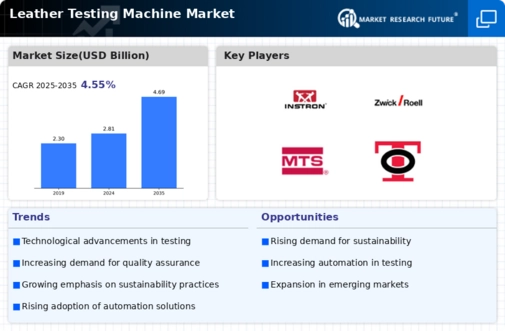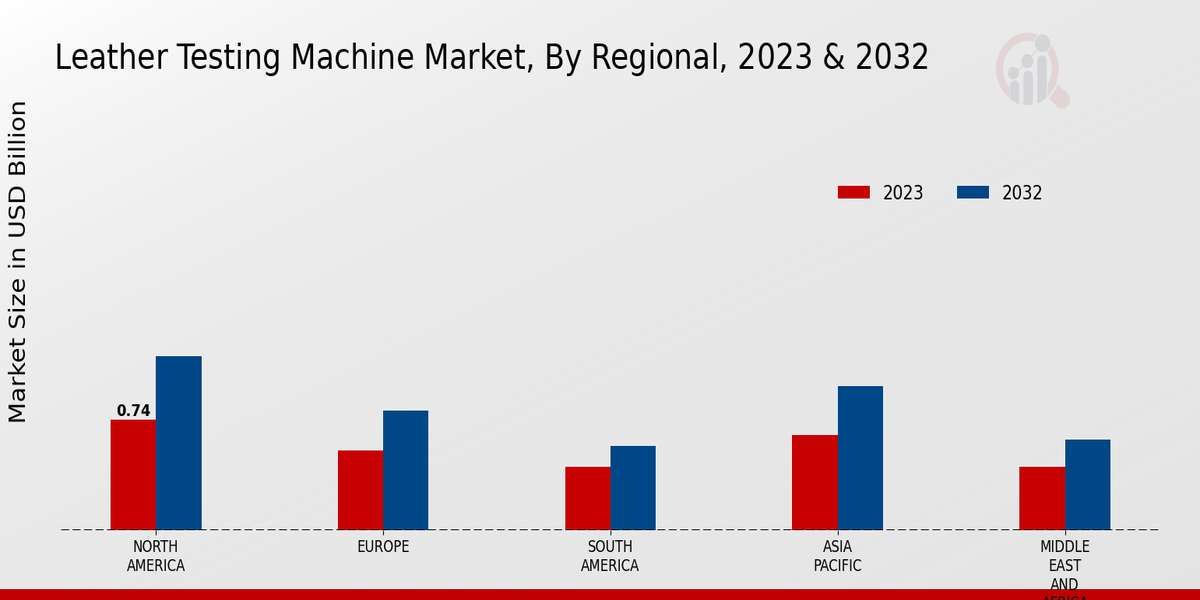Market Growth Projections
The Global Leather Testing Machine Market Industry is poised for substantial growth, with projections indicating a market value of 2.81 USD Billion in 2024 and an anticipated increase to 4.69 USD Billion by 2035. This growth trajectory suggests a robust demand for leather testing solutions driven by various factors, including quality assurance, technological advancements, and regulatory compliance. The expected CAGR of 4.76% from 2025 to 2035 further underscores the industry's potential for expansion. As manufacturers continue to prioritize product quality and sustainability, the market for leather testing machines is likely to flourish, reflecting the evolving dynamics of the global leather industry.
Expansion of the Leather Industry
The expansion of the leather industry globally is a significant driver for the Global Leather Testing Machine Market Industry. As the demand for leather products continues to rise, particularly in emerging markets, manufacturers are ramping up production. This growth necessitates the implementation of comprehensive testing protocols to ensure product quality and safety. Countries such as India and Brazil are witnessing a boom in leather production, leading to increased investments in testing machinery. The market is expected to grow from 2.81 USD Billion in 2024 to an estimated 4.69 USD Billion by 2035, reflecting the industry's robust expansion and the corresponding need for advanced testing solutions.
Regulatory Compliance and Standards
Regulatory compliance remains a critical factor influencing the Global Leather Testing Machine Market Industry. Governments and international bodies are increasingly establishing stringent regulations regarding the safety and environmental impact of leather products. Compliance with these regulations necessitates the use of advanced testing machines capable of assessing various parameters, including chemical composition and physical properties. Manufacturers are compelled to invest in testing equipment that meets these standards to avoid penalties and ensure market access. This regulatory landscape is expected to drive market growth, as companies seek to align their operations with legal requirements and consumer expectations.
Rising Demand for Quality Assurance
The Global Leather Testing Machine Market Industry is experiencing a surge in demand for quality assurance in leather products. As consumers become increasingly discerning about the quality of leather goods, manufacturers are compelled to adopt rigorous testing protocols. This trend is particularly evident in regions with stringent regulations on leather quality, such as Europe and North America. The need for compliance with international standards drives the adoption of advanced testing machines, which ensure that products meet safety and durability criteria. Consequently, this heightened focus on quality assurance is expected to contribute significantly to the market's growth, with projections indicating a market value of 2.81 USD Billion in 2024.
Consumer Awareness and Sustainability Trends
Consumer awareness regarding sustainability and ethical sourcing is reshaping the Global Leather Testing Machine Market Industry. As consumers become more informed about the environmental impact of leather production, there is a growing demand for sustainably sourced and processed leather. This shift in consumer preferences compels manufacturers to adopt testing machines that can evaluate the sustainability of their products. Companies are increasingly focusing on eco-friendly practices, which include testing for harmful substances and ensuring compliance with environmental regulations. This trend not only enhances brand reputation but also drives the need for advanced testing solutions, contributing to the overall growth of the market.
Technological Advancements in Testing Equipment
Technological advancements play a pivotal role in shaping the Global Leather Testing Machine Market Industry. Innovations in testing methodologies and equipment have led to more efficient and accurate assessments of leather properties. For instance, the integration of automation and digital technologies enhances the precision of tests, reducing human error and increasing throughput. Manufacturers are increasingly investing in state-of-the-art testing machines that offer real-time data analysis and reporting capabilities. This trend not only improves operational efficiency but also ensures compliance with evolving industry standards. As a result, the market is likely to witness substantial growth, with a projected CAGR of 4.76% from 2025 to 2035.






